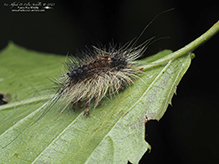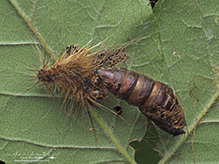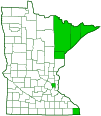spongy moth (formerly gypsy moth)
(Lymantria dispar)
Conservation • Pest • Description • Habitat • Ecology • Distribution • Taxonomy
|
|
||||||||||||||||||
Pest Status |
|
| Global | The Invasive Species Specialist Group (ISSG) of the International Union for Conservation of Nature (IUCN) includes spongy moth in its 2014 publication 100 of the World's Worst Invasive Alien Species. |
United States |
Spongy moth is a significant nonnative forest pest in the United States. It is currently under quarantine in the eastern part of the country. The USDA Forest Service requires that persons moving from infected areas inspect campers, recreational vehicles, and outdoor household articles, including garbage cans, lawn furniture, and children’s toys, for all spongy moth life stages. |
| Minnesota | Spongy moth is listed as an invasive terrestrial species in Minnesota. |
Description |
Spongy moth, formerly called gypsy moth, is a common, exotic, invasive, tussock moth. It is native to Europe and Asia. It was accidentally introduced from Europe into North America in 1869 in Boston, Massachusetts. It now occurs in the United States from Maine to northern North Carolina, west to eastern Minnesota and northern Illinois. It also occurs in southern Canada from Nova Scotia to Ontario. Spongy moth larvae feed on the leaves of more than 300 species of deciduous trees and shrubs and on white pine. Adults are found from June to mid-July in deciduous and mixed forests and woodlands, in parks, and in residential yards. Spongy moth adults are chunky and extremely hairy. Males and females are very different in both size and appearance. Moth sizes are sometimes given in terms of forewing length. Males have a ⅝″ to ¾″ (15 to 19 mm) forewing length and a ⅝″ to ¾″ (15 to 19 mm) wingspan. Females are much larger. They have a ⅞″ to 1⅛″ (23 to 29 mm) forewing length and a 2 9⁄16″ (64 mm) wingspan. On the male, the antennae are feather-like, with long branches on both sides (bipectinate). The body is dark brown. The forewings are short, broad, rounded, and light brown to yellowish brown, with dark brown lines and spots. They are moderately dusted with dark brown scales. The antemedial (AM), postmedial (PM), and subterminal (ST) lines are diffuse and deeply scalloped. All three lines broaden into a black spot on the leading edge (costal margin). The area beyond the ST line is shaded dark brown. The terminal line consists of a series of black dots. The circular spot (orbicular spot) in the upper median area is a small black dot. The kidney-shaped spot (reniform spot) in the lower median area consists of three black spots that usually merge into a crescent shape. The fringe is checkered. The hindwing is light brown with dark shading on the veins and a dark brown band on the outer margin. On the female, the antennae are also feather-like, but with short branches on both sides. The body is whitish. The forewings are longer and ivory white. The lines are faint. The reniform spot is a complete crescent. Though the wings are fully developed, the female is barely capable of flight. The hindwings are uniformly cream colored. They are unmarked except for a terminal line of black dots. The caterpillar is about 2 3⁄16″ (5.5 cm) in length. It is instantly recognizable by five pairs of blue warts followed by six pairs of red warts on the upper side, and by bulging warts on each side of the head bearing long, bristle-like hairs (setae). ---------------------------------------------------- The description above refers to Lymantria dispar dispar, the only subspecies that occurs in Minnesota. |
Size |
Female wingspan: 2 9⁄16″ (64 mm) Female forewing length: ⅞″ to 1⅛″ (23 to 29 mm) Male wingspan: 1½″ (38 mm) Male forewing length: ⅝″ to ¾″ (15 to 19 mm) |
Similar Species |
Habitat |
Deciduous and mixed forests and woodlands, parks, and residential yards |
Ecology |
Season |
One generation per year: June to mid-July |
Behavior |
The male is active during the day but is also attracted to light at night. |
Life Cycle |
During the summer, the female eventually becomes too heavy with eggs to fly. She attaches an egg mass to the trunk or branch of a tree, a stone, a wall, a log, or another nearby object. The egg mass is buff colored, velvety, about 1½″ (38 mm) long, and about ¾″ (20 mm) wide. It contains 100 to 800 eggs, and it is embedded with hairs from the abdomen of the female. It appears somewhat sponge-like, and this is the source of the moth’s new common name. Eggs overwinter and hatch the following spring in late April or early May. |
Larva Food |
Leaves of more than 300 species of deciduous trees and shrubs and white pine |
Adult Food |
|
Damage |
The favored hosts of spongy moth include oak, apple, alder, basswood, birch, poplar, sweet gum, willow, and hawthorn. However, the caterpillars feed on more than 300 species of deciduous trees and shrubs and sometimes on white pine. Early stage (instar) caterpillars chew holes in the leaves. Late instars consume the entire leaves except for the midrib. The entire tree can be defoliated, causing reduced growth, loss of vigor, susceptibility to disease, reduced value to other wildlife, and reduced aesthetic and recreational value. Several successive years of defoliation can cause the death of the tree. Outbreaks occur in some forested areas where oaks comprise at least 15% to 25% of the stand. They may cover several hundred thousand acres during the worst years. Heavy defoliation may occur in somewhat interrupted areas, but the outbreaks do not result in the deforestation of large areas. |
Biological Pest Control |
entomophagus fungus (Entomophaga maimaiga) European tachinid fly (Compsilura concinnata) was introduced into North America in 1906 as a biocontrol agent for spongy moth. However, it also parasitizes moths in the Nymphalidae and Saturniidae families. parasitic wasp (Cotesia melanoscelus) parasitic wasp (Ooencyrtus kuvanae) |
Distribution |
||
|
Sources 4, 6, 7, 21, 22, 24, 27, 29, 30, 71, 75, 82, 83. The Minnesota Department of Agriculture Spongy Moth Program has conducted annual detection trapping surveys for spongy moths since 1973. They have successfully eradicated all small, isolated infestations that have been found throughout the state eradication area. |
|
| 11/10/2024 | ||
Occurrence |
||
Common in the east, uncommon in Minnesota |
||
Taxonomy |
|
Order |
|
Superfamily |
Noctuoidea (owlet moths and allies) |
Family |
Erebidae (underwing, tiger, tussock, and allied moths) |
Subfamily |
Lymantriinae (tussock moths) |
Subtribe |
Lymantriini |
Genus |
Lymantria |
Subgenus |
Porthetria |
Subordinate Taxa |
|
There are three subspecies of Lymantria dispar, two of which have been introduced into North America. The European subspecies, Lymantria dispar dispar, was imported from Paris, France into Boston, Massachusetts in the 1869 in an attempt to discover an alternative source of silk. Some of the moths escaped. Spongy moth now occurs in the northeastern and north-central United States and in southern Canada. The Asian subspecies, Lymantria dispar asiatica, was first detected along the West Coast of North America in the 1990s. It now occurs in the U.S. from northern Washington to southern California, and in southern British Columbia Canada. The remaining subspecies, Lymantria dispar japonica, occurs throughout Japan. |
|
Asian spongy moth (Lymantria dispar asiatica) flighted spongy moth (Lymantria dispar japonica) spongy moth (Lymantria dispar dispar) |
|
Synonyms |
|
Lymantria andalusiaca Lymantria asiatica Lymantria bocharae Lymantria chosensis Lymantria hokkaidoensis Lymantria kolthoffi Lymantria koreibia Lymantria mediterraneae Lymantria praeterea Ocneria erebus Phalaena dispar |
|
Common Names |
|
gypsy moth spongy moth |
|
On July 7, 2021, the Entomological Society of America removed “gypsy moth” and “gypsy ant” as recognized common names in its Common Names of Insects and Related Organisms List. The term “gypsy” was deemed to be a derogatory term for the Romani people. On March 2, 2022, they formally adopted “spongy moth” as the new common name for Lymantria dispar. |
|
Glossary
Antemedial (AM) line
A thin line separating the basal area and the median area of the forewing of Lepidoptera.
Costal margin
The leading edge of the forewing of insects.
Instar
The developmental stage of arthropods between each molt; in insects, the developmental stage of the larvae or nymph.
Orbicular spot
A circular spot or outline in the upper median area near the antemedial line on the forewing of many moths.
Postmedial (PM) line
A thin line separating the median area and the postmedial area of the forewing of Lepidoptera.
Reniform spot
A kidney-shaped spot or outline in the lower median area near the PM line on the forewing of many moths.
Seta
A stiff, hair-like process on the outer surface of an organism. In Lepidoptera: A usually rigid bristle- or hair-like outgrowth used to sense touch. In mosses: The stalk supporting a spore-bearing capsule and supplying it with nutrients. Plural: setae. Adjective: setose.
Visitor Photos |
||
Share your photo of this insect. |
||
This button not working for you? |
||
Alfredo Colon |
||
 |
||
 |
 |
|
 |
 |
|
MinnesotaSeasons.com Photos |
||
|
||
|

Slideshows |
Lymantriidae - Lymantria dispar |

|
About
Gypsy moth |

Visitor Videos |
||
Share your video of this insect. |
||
This button not working for you? |
||
|
Other Videos |
||
GYPSY MOTH Information (Lymantria dispar) |
About
Jul 10, 2018 |
Lymantria dispar dispar infestation west central NY |
About
Jul 10, 2021 100's of Square miles of trees are gone. @nysdecvideos Lymantria dispar dispar is a species of moth in the family Erebidae that is of Eurasian origin. It was previously known as the gypsy moth. |
UMass Extension's InsectXaminer Episode 1 Spongy Moth (Lymantria dispar) Life Cycle and Pathogens |
About
May 19, 2022 The first episode of InsectXaminer features spongy moth (Lymantria dispar). Join UMass Extension as we get an up close and personal view of this invasive insect's life cycle and two pathogens that help keep spongy moth populations below outbreak levels in Massachusetts. |

Visitor Sightings |
||
Report a sighting of this insect. |
||
This button not working for you? |
||
Alfredo Colon |
Location: Albany, NY |
 |
| Alfredo Colon 8/21/2022 |
Location: Albany, NY |
 |
| Alfredo Colon 8/19/2022 |
Location: Albany, NY |
 |
MinnesotaSeasons.com Sightings |
||
|

Created: 12/14/2023 Last Updated: © MinnesotaSeasons.com. All rights reserved. |
